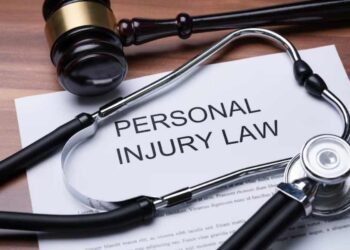If you’ve been involved in a personal injury case, you may have heard the term “economic damages” used by your lawyer or in discussions about compensation. But what exactly does it mean? What are economic damages in a personal injury case? Simply put, economic damages refer to the tangible, calculable losses that an injured party suffers due to an accident or negligent behavior. These damages are meant to compensate for financial losses directly caused by the injury.
In a personal injury lawsuit, economic damages can encompass a wide range of expenses. From medical bills and lost wages to the cost of future care, these damages are crucial for ensuring that an injured party is made whole financially. Understanding what constitutes economic damages and how they are calculated can help individuals navigate their cases with more clarity and confidence.
This guide will break down everything you need to know about what economic damages in a personal injury case entail, including the types of economic damages, how they are calculated, and why they are an important part of personal injury settlements. Whether you’re filing a claim or just curious about the process, this article will provide you with comprehensive insights into the subject.
What are economic damages in a personal injury case?
Economic damages are the quantifiable financial losses that a person experiences due to an injury, such as medical expenses, lost wages, and the cost of future care. These damages aim to compensate for actual, measurable losses resulting from the injury. Unlike non-economic damages, which address pain and suffering, economic damages are calculated using specific, documented expenses and losses.
The Basics of Economic Damages in a Personal Injury Case
In a personal injury case, economic damages refer to the tangible financial losses directly resulting from an injury. These damages are distinct from non-economic damages like pain and suffering, as they are measurable and quantifiable. Economic damages aim to compensate for actual financial burdens such as medical expenses, lost wages, and future care costs, which can all be clearly documented.
Common types of economic damages include medical expenses, lost wages, and future care costs. Medical expenses cover the costs of treatments, hospital visits, surgeries, medications, and rehabilitation, supported by medical records and bills. Lost wages refer to income lost due to the injury, including both current and future earnings if the injury leads to long-term disability. Future care costs involve the projected expenses for ongoing treatments or assistance required because of the injury.
For example, if someone is injured in a car accident, their medical bills for emergency treatment, surgeries, and physical therapy would be included in their economic damages. If the injury prevents them from working, they may also claim lost wages. Additionally, if the injury requires long-term care, the cost of this care could also be included in the total economic damages. These damages are crucial for ensuring that the injured party is financially compensated for their measurable losses.
How Are Economic Damages Calculated in Personal Injury Cases?
Medical Expenses
The first step in calculating economic damages is adding up all medical expenses related to the injury. This includes immediate treatment costs, emergency services, hospital stays, surgeries, follow-up visits, medication, and therapy sessions. Keep all bills, invoices, and receipts to support the calculation of medical expenses.
Lost Wages
If the injury causes the individual to miss work, the lost wages must be calculated. This includes the person’s regular salary, as well as any bonuses, benefits, or commissions they would have earned during the time they were unable to work. Documentation like pay stubs and income records will be necessary to support the claim for lost wages.
Future Medical Expenses
In cases where the injury results in a long-term or permanent disability, future medical expenses may need to be considered. These could include ongoing treatments, therapy, medications, and even home healthcare. Estimating these costs requires expert opinions or testimony from healthcare providers who can project future care needs.
Special Equipment or Modifications
In some cases, the injured person may need special equipment, such as wheelchairs, prosthetics, or other devices to assist with their daily living. Additionally, modifications to the home or vehicle may be necessary. The cost of these items should be included in the calculation of economic damages.
When Do Economic Damages Apply in a Personal Injury Case?
Economic damages are applicable when a personal injury results in measurable financial losses. These damages are awarded to compensate the plaintiff for the direct financial impact of the injury, which can occur immediately after the incident or continue throughout the recovery period and beyond.
Immediate Costs: Economic damages apply immediately after the injury, covering costs such as medical bills, emergency care, hospital visits, and medications. Lost wages also fall under this category if the injury prevents the individual from working in the short term. These immediate costs are the most straightforward since they rely on documented expenses.
Ongoing Costs: For severe injuries, economic damages extend to future costs, including ongoing medical treatment, physical therapy, and necessary long-term care. If the injury leads to permanent disability, the plaintiff may also be compensated for future lost earnings and the cost of future care, such as home health aides or special equipment.
Temporary vs. Permanent Injuries: Economic damages apply to temporary and permanent injuries. For temporary injuries, such as fractures or soft tissue injuries, damages typically cover medical expenses and lost wages during recovery. However, permanent injuries or disabilities that result in long-term care or loss of earning capacity lead to long-term economic damages. The calculation of future lost earnings often requires expert input, such as the testimony of a vocational expert or financial analyst, to estimate how the injury will affect future income.
How Do Economic Damages Differ From Non-Economic Damages?
Economic and non-economic damages are essential components of a personal injury case, yet they differ significantly. While both types of damages compensate the injured party, they apply to different losses and are calculated differently.
Economic damages are awarded to cover tangible, measurable financial losses resulting from the injury. These damages include medical expenses, lost wages, future lost earnings, and future medical care. They are based on actual, documented costs, making them easier to calculate. For example, medical expenses are typically supported by bills and invoices, while lost wages can be verified using pay stubs and other income documentation. Economic damages return the injured person to their financial position before the injury occurred, compensating them for the actual, quantifiable losses they have incurred.
In contrast, non-economic damages compensate for intangible losses that are not financially measurable. These damages address the emotional and psychological impact of the injury. Non-economic damages include compensation for pain and suffering, emotional distress, and loss of enjoyment of life. These damages are often more subjective, as they require testimony about the personal toll the injury has taken on the plaintiff. While economic damages are calculated using objective figures, non-economic damages are more fluid and vary widely depending on the case.
The distinction between economic and non-economic damages is important because it helps ensure a comprehensive approach to compensation. Economic damages can be directly calculated and substantiated through documentation, while non-economic damages require a more subjective evaluation of how the injury has affected the plaintiff’s quality of life. Both damages are crucial to providing a fair and complete settlement or judgment for the injured party.
What Is the Role of a Lawyer in Economic Damages Claims?
When it comes to personal injury claims, especially those involving complex economic damages, the role of a lawyer is essential. A skilled attorney can ensure that the plaintiff’s claim for economic damages is properly calculated, substantiated, and presented to the court or insurance company.
Legal Expertise and Guidance
A lawyer with expertise in personal injury law will help the client understand what qualifies as economic damages and what documentation is needed to substantiate these claims. They will guide the plaintiff through the legal process, ensuring that all necessary paperwork is filed and deadlines are met.
Collecting Evidence and Documentation
To prove economic damages, it is essential to gather and present solid evidence. This includes medical bills, employment records, and expert testimony to support claims for future medical expenses or lost earnings. A lawyer will ensure that all this documentation is properly collected, organized, and presented in a way that strengthens the case.
Estimating Future Economic Damages
One of the most challenging aspects of economic damages claims is estimating future financial losses. A personal injury lawyer often works with medical experts, financial analysts, and vocational experts to calculate how much the injury will cost the plaintiff in the long term. This can include projections for future medical care, future lost wages, and the cost of accommodations for permanent disabilities. A lawyer ensures that these estimates are as accurate as possible, helping the client receive fair compensation.
Negotiating with Insurance Companies
Insurance companies often try to minimize the amount they pay out in personal injury claims. A lawyer will advocate on the plaintiff’s behalf during negotiations, ensuring that the insurance company offers a fair settlement that fully covers the economic damages. If the settlement offered by the insurance company is inadequate, a lawyer will help the client pursue the case in court, seeking to secure a higher award for the damages.
Trial Representation
If the case goes to trial, the lawyer will represent the plaintiff in presenting their evidence and making their case to the judge or jury. In cases involving significant economic damages, having an experienced attorney in court is crucial to ensure that the plaintiff receives the full compensation they deserve.
Wrapping Up
Economic damages are a vital component of any personal injury case, as they aim to compensate the plaintiff for tangible financial losses caused by the injury. These damages cover everything from medical expenses to lost wages and future care costs, all of which are essential to restoring the injured party’s financial stability. Understanding what economic damages in a personal injury case entail helps ensure that plaintiffs receive the full compensation they deserve.
Working with an experienced personal injury lawyer is crucial to accurately calculating and documenting economic damages, ensuring a fair settlement or trial outcome.
FAQs
Q. What are economic damages in a personal injury case?
A. Economic damages are the measurable financial losses someone suffers from an injury, such as medical bills, lost wages, and the cost of future care.
Q. How are economic damages calculated?
A. Economic damages are calculated by adding documented expenses, including medical treatment, lost wages, and future care costs.
Q. Are future medical expenses part of economic damages?
A. Future medical expenses can be included if the injury requires ongoing care or treatment.
Q. How do economic damages differ from non-economic damages?
A. Economic damages are based on tangible financial losses, while non-economic damages cover intangible losses like pain and suffering.
Q. Do I need a lawyer to claim economic damages?
A. While you can file a claim without a lawyer, having a skilled attorney ensures your economic damages are accurately calculated and fully represented in your case.










